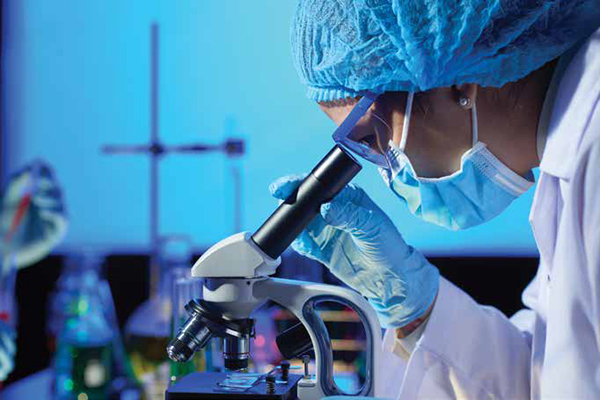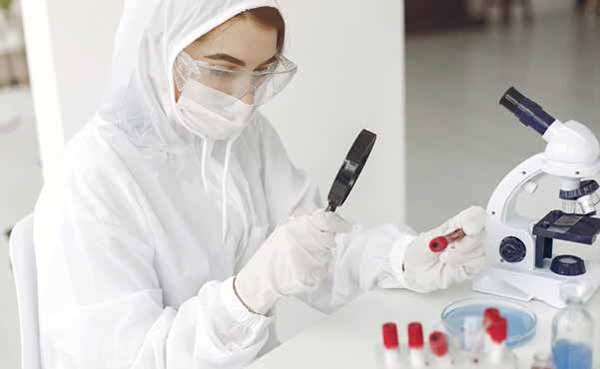Laboratory medicine is continuously evolving to provide the much needed support for disease monitoring, treatment decisions and patient safety. With a rise in the adoption of machine learning and artificial intelligence to improve turnover and optimise efficiency, pathology laboratories are transforming into predictive rather than reactive environments.

Diagnostics is the critical first step in the healthcare delivery chain, as 70 per cent of the treatment decisions are based on lab results. The market for diagnostics devices is growing steadily to meet the increasing demand from hospitals and laboratories. The onus is thus on the manufacturer to provide a holistic solution that integrates automation with analytics, training, updates, and troubleshooting. Further, the use of QR codes and RFID chips enables automated tracking of samples and laboratory materials such as reagents, chemicals and equipment.
Today, digitalisation, automation, and laboratory information software (LIS) have found a place in clinical laboratories. However, many lab processes continue to be performed manually or are partially digitised. Efforts are also being taken to improve the pre-analytic, analytic, and postanalytic processes of the clinical laboratories with the AI-support.
The COVID-19 outbreak accelerated the adoption of digital technologies in laboratories. According to a recently published report, several examples of applications of Artificial Intelligence (AI) to COVID-19 are already reported such as AI-enabled outbreak tracking apps, chatbots for diagnostics, AI-powered analysis of scientific publications and triage using natural language processing (NLP) for screening potential patients and prognosis prediction tools, and using radiology CT scans to manage system capacities, among others.
Also available on record are multiple examples of the role played by AI in the management of non-communicable chronic diseases such as cancer and cardiovascular disorders. AI tools aid in augmenting the accuracy of clinical decision and improving patient care.
Studies reveal that AI-supported systems can predict patient waiting time in the phlebotomy unit and organise the entire blood collection process or the autoverification of test results using a Machine Learning (ML) approach. ML can also be used to predict out-ofcontrol events in internal quality control studies, detecting instrument failures before even they occur, or determining compatibility between analysers in central laboratories where several instruments running the same parameters are tested.
It is very interesting that the basic manual laboratory techniques and procedures have generally been adopted in principle to automated, or mechanised, fashion in automated analysers, while a wide variety of configurations can be observed in modern instrumentation in clinical laboratory. Step-by-step innovations created these ultimate configurations.
There are several approaches to automated instrumentation historically. For instance, multiple samples are tested in a series in batch analysers. In contrast, in sequential analysers, the samples are tested sequentially, and the results are reported at that order. Continuousflow analysis means a form of sequential analysis with a continuous stream. In random-access discrete analysers, the most common configuration, analyses are performed sequentially on a set of specimens, and each sample can be analysed for a different test selection. In this type of analysis, an interruption can occur in routine working for spanning a stat sample in-between, permitting measurement of a number of and a variety of analytes in each specimen. Discrete term in this type of analysers means that each test of a patient (or a sample) is analysed in a distinct chamber (in a well, cuvette, reaction vessel)
The use of automated analysers has many advantages including reduction of workload, less time consumption per sample analysis, more number of tests done in less time, use of minute amount of sample, decreased chances of human errors, and high accuracy and reproducibility.
Further, Total Laboratory Automation (TLA) systems use conveyor belts to connect pre-analytical specimen processing and other functions directly to an analyser. Such systems also include functions such as post-analytical storage or sorting of specimens or aliquots to be transported to low-volume testing areas—or to be sent to reference laboratories.
At Transasia-Erba Group, we are looking forward to launching exciting new products by 2023. Our R&D labs in France, UK, USA, Austria and India will launch over 10 state-of-the-art analysers in CLIA, molecular, high-end haematology, AI and LIS. Also in the offing is a TLA solution aimed at midand large size laboratories. All these will make Transasia-Erba among the top-five companies globally to have ‘Total solutions in Laboratory Diagnostics.
Modern-day cutting edge smart technologies are giving a much-needed renovation to laboratories and making them ‘smart’. A smart laboratory is nothing but an amalgam of different hardware tools and software that helps in data management, which is one of its integral parts. And when it comes to data management, one cannot ignore the concept of digital data management.
The concept of digital data management generally revolves around utilising tools to store, document, and share, analyse and manage the experimental data. Among all the other software available, Laboratory Information Management System (LIMS) is extremely helpful. LIMS is a software solution that helps in addressing data management, regulatory challenges, and automation. This software is extremely useful in handling laboratory samples and the data. As a result, it helps maintain tests, workflows and reporting techniques that assist in standardising operations.
The most significant part of the LIMS is to enhance the operational efficiency of a lab by streamlining and automating workflows. Also, it eliminates the purpose of manually maintaining information and complying with regulations. An efficient LIMS will easily be able to keep records and report them. As a result, it eliminates the possibility of any human errors.
The key advantage of using LIMS is that it provides sample management. It means that with the help of LIMS, it is possible to manage accurate and detailed records of every sample and securely store them. As a result, the data is not lost while it moves from one laboratory to another.
Secondly, the inventory management functionality of LIMS makes it possible to manage reagents and stock supplies. In addition, it also helps in generating automatic recorder alerts in time of depletion of the stock.
Test Management and reporting are the other two benefits of using the Laboratory Information Management System. It is possible to achieve standardised testing structures with the help of LIMS that too with the bonus of providing accurate and complete testing process control.
With an increasing focus on offering value-added services, manufacturers are adopting rapidly evolving technologies, such as the Internet of Things (IoT), to meet the huge demand for fully automated products and services.
IoT applications are being used across all industries and healthcare is no exception. In fact, IoT has brought in a lot of ‘convenience’ to the healthcare ecosystem, becoming especially useful for medical device providers. While it offers a host of solutions, it is left to the companies to leverage the potential of IoT to the fullest.
For laboratories, one of the biggest concerns is downtime. Planning for upgrading via cloud-based lab management systems and sophisticated software is a good way to future proof products and reduce the cost of maintaining the instrument. The days of preventive maintenance are long forgotten, now is the time for predictive maintenance. Devices with IoT capability can sense when components are exhibiting faults or when they near their expected end of life and communicate this back to technical support and initiate actions to resolve them – from ordering replacement parts to requesting a completely new device.

Remote monitoring is also used to evaluate the usage and consumption of reagents for each test and their expiry to allow efficient management of lab inventory and utilisation. Further, by analysing actual usage data, a company can provide better customer service by pre-scheduling the delivery of consumables. This is particularly relevant for a diagnostic laboratory that is faced with a major challenge of optimising capacities of capital equipment.
While nothing can replace personalised customer service, IoT is playing the role of an adjunct to ‘smarter’ personalised customer service. In the traditional approach, a device manufacturer provides after-sales service to solve a problem with the instrument in case of a breakdown. This could result in repeated visits by the sales team to first diagnose the problem and then fix it. However with IoT, the service team can receive real-time reports. Technicians can thus remotely access the instrument and get information on the performance and repair history and other details that can help them save time. This will further help the organisation to improve their TAT and customer satisfaction.
Manufacturers can utilise IoT data for compliance monitoring and to evaluate the performance of an instrument and optimise test results real time, with QC rules and calibration trends. This can be integral to making the device more useful to the end-user.
Transasia’s cloud-based system, Transconnect, has helped equip labs with cutting-edge technology to improve patient treatment outcomes and enable better analytic insights. Its sophisticated software provides the team with real-time updates, prompting timely intervention to avoid a breakdown. In addition, a round the clock application support guarantees a seamless lab workflow. IoT sensors integrated in the instruments, provides extensive information on the consumption of reagents and the thus enhances the efficiency of the lab.
Cloud Computing is the method of using remote servers and networks that are hosted on the internet for saving, managing, processing the enormous data of the company or a firm. For a large number of laboratories, the data collected from various sources like experiments, research, and development activities are much more valuable. In order to keep them safe and secured, it is mandatory to keep in enormous and massive storage, and that’s where cloud computing comes into the picture.
Data and files collected is a genuine record that has been performed or experimented. It is an asset to the company or a laboratory. Thus, it is necessary to safeguard and store in a safer place.
Moreover, cloud computing helps a lab to prevent the loss of files and vital data.
Increase revenue and profits: Laboratories and healthcare management companies can make use of the robust metrics, MIS dashboards, with fingerprints metrics to have an eye on the recent trends and projections to maximise profits and revenues.
Increase brand reputation: Extensive usage of cloud computing can help a laboratory or a healthcare company to give a delightful patient experience. Moreover, cloud computing provides accuracy in reports and diagnoses, which satisfies the patients and ultimately makes them happy.
Productivity: With the use of cloud computing, laboratories and healthcare companies can increase the workflow and work productivity, respectively. They can maximise productivity by leveraging EM flow as well as automation across several departments of the laboratories. Cloud computing is the one-size solution that fits all the companies that boosts productivity and streamlines business workflow.
With the help of cloud computing, labs can streamline business operations. Moreover, they can centralise data, strategies the company data, and safeguard the same adequately.
Disruptive technologies will fundamentally change the way laboratory tests are going to be ordered, carried out and interpreted in the future. Data will be stored in cloud services, and a 24/7 online availability of health services will strengthen predictive medicine. This may also enable improved preventive healthcare that is supported by deep-learning algorithms for clinical decision-making not only on behalf of the physician, but also the empowered patient.